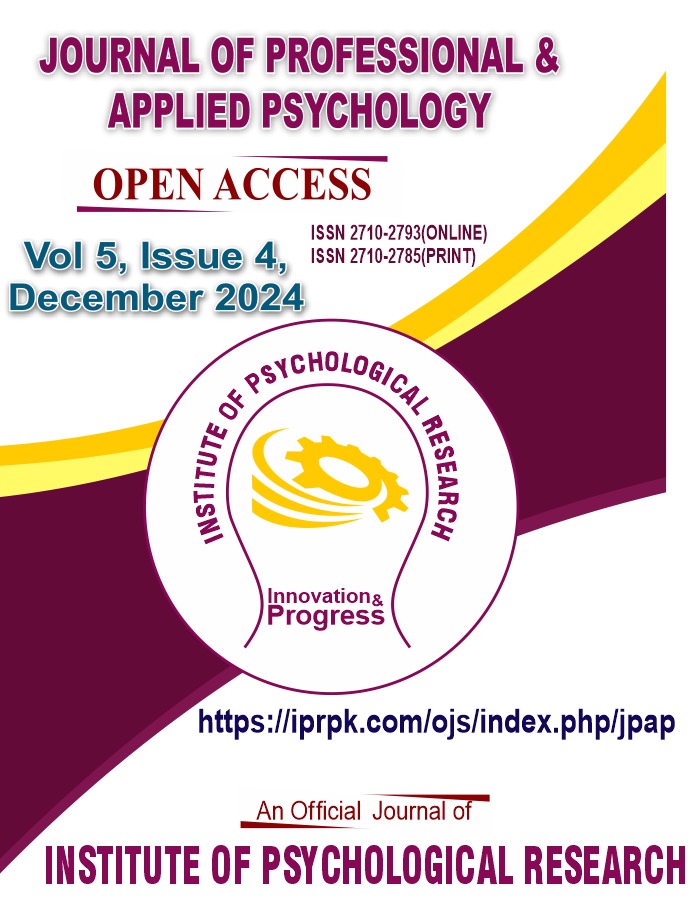Perceived Neglect, Submissive Behavior and Psychological Distress among Orphans
DOI:
https://doi.org/10.52053/jpap.v5i4.347Keywords:
Orphans, Perceived Neglect, Psychological Distress, Submissive BehaviorAbstract
This study aimed to explore the relationship between perceived neglect, submissive behavior, and psychological distress among orphans. The study also examines the gender difference in the terms of perceived neglect, submissive behavior and phycological distress. In this study, correlation method was used and a purposive sample strategy was used to choose 100 orphans from different orphanage. The results indicate a significant relationship between psychological distress, submissive behavior and perceived neglect, the findings suggesting that higher perceived neglect levels were associated with higher psychological distress and submissive behavior. Gender difference was also noted, boys reported higher levels of psychological distress and felt neglect than girls. To reduce the negative impact of neglect and psychological distress, the study recommends implementing and responding to the effects of trauma in a compassionate and supportive manner. By addressing the specific needs of orphans and acknowledging gender differences, the study emphasizes the necessity of tailored interventions to support orphans.
References
Akin, A. (2009). Self-compassion and submissive behavior. Egitim ve Bilim, 34(152), 138. DOI: 10.15390/EB.2009.3051
Allan‚ S. & Gilbert‚ P. (1997). Submissive behavior and psychopathology. British Journal of Clinical Psychology‚ 36‚ 467-488.
Atwine, B., Cantor-Graae, E., & Bajunirwe, F. (2005). Psychological distress among AIDS orphans in rural Uganda. Social Science & Medicine, 61(3), 555564. doi: http://dx.doi.org/10.1016/j. socscimed.2004.12.018
Bandura, A. (1969). Social-learning theory of identificatory processes. Handbook of socialization theory and research, 213, 262. https://psycnet.apa.org/doi/10.1037/0012-1649.28.5.776
Barker, G., Olukoya, A., Moraes, M., & Santos, I. (2019). The impact of childhood neglect and abuse on children’s emotional and social development. International Journal of Social Psychiatry, 65(5), 399-406. DOI: 10.1177/0020764019862782
Blumberg, H. P., Donegan, N. H., Sanislow, C. A., Collins, S., Lacadie, C., Skudlarski, P., Gueorguieva, R., Fulbright, R. K., McGlashan, T. H., Gore, J. C., & Krystal, J. H. (2005). Preliminary evidence for medication effects on functional abnormalities in the amygdala and anterior cingulate in bipolar disorder. Psychopharmacology, 183(3), 308–313. https://doi.org/10.1007/s00213-005-0156-7
Bowlby, J. (1979). The bowlby-ainsworth attachment theory. Behavioral and Brain Sciences, 2(4), 637-638. https://doi.org/10.1017/S0140525X00064955
Cohen, J. A., Mannarino, A. P., Berliner, L., & Deblinger, E. (2000). Trauma-focused cognitive behavioral therapy for children and adolescents: An empirical update. Journal of Interpersonal Violence, 15(11), 1202-1223. https://doi.org/10.1016/j.beth.2017.07.003
Cluver, L. D., & Gardner, F. (2007). The mental health of children orphaned by AIDS: A review of international and southern African research. Journal of Child & Adolescent Mental Health, 19(1), 117. doi: http://dx.doi.org/10.2989/17280580709486631
Decker, F. H. (1997). “Occupational and non-occupational factors in job satisfaction and psychological distress among nurses”. Research in Nursing & Health, 20, 453-464.
Doku, P. N. (2009). Parental HIV/AIDS status and death, and children’s psychological wellbeing. International Journal of Mental Health Systems, 3(1), 26. doi: http://dx.doi.org/10. 1186/1752-4458-3-26
Gilbert, P. (2000). The relationship of shame, social anxiety and depression: The role of the evaluation of social rank. Clinical Psychology & Psychotherapy: An International Journal of Theory & Practice, 7(3), 174-189. https://doi.org/10.1002/1099-0879(200007)7:3%3C174::AID-CPP236%3E3.0.CO;2-U
Kessler, R.C., Andrews, G., Colpe, L. J., Hiripi, E., Mroczek, D. K., Normand, S.-L. T., Walters, E. E., & Zaslavsky, A. M. (2002). Short screening scales to monitor population prevalences and trends in non-specific psychological distress. Psychological Medicine, 32(6), 959–976. https://doi.org/10.1017/S0033291702006074
Masten, A. S., & Narayan, A. J. (2012). Child development in the context of disaster, war, and terrorism: Pathways of risk and resilience. Annual Review of Psychology, 63(1), 227-257. https://doi.org/10.1146/annurev-psych-120710-100356
Puffer, E. S., Drabkin, A. S., Stashko, A. L., Broverman, S., OgwangOdhiambo, R., & Sikkema, K. J. (2012). Orphan status, HIV risk behavior, and mental health among adolescents in rural Kenya. Journal of Pediatric Psychology, 37(8), 868878. doi: http://dx.doi.org/10.1093/jpepsy/jss077
Singh, J. (2018). A comparative study on the levels of anxiety and depression experienced by orphaned and non-orphaned children in Sowetan primary schools. University of Johannesburg (South Africa).
Straus, M. A., & Kantor, G. K. (2005). Definition and measurement of neglectful behavior: Some principles and guidelines. Child Abuse & Neglect, 29(1), 19-29. doi: 10.1016/j.chiabu.2004.08.005
Vermeulen, M., & Mustard, C. (2000). Gender differences in job strain, social support at work, and psychological distress. Journal of Occupational Health Psychology, 5(4), 428. https://psycnet.apa.org/doi/10.1037/1076-8998.5.4.428
Downloads
Published
How to Cite
Issue
Section
Categories
License
Copyright (c) 2024 Fareeha Jabeen, Iram Ijaz

This work is licensed under a Creative Commons Attribution-NonCommercial 4.0 International License.
Creative Commons Attribution-Non Commercial 4.0 International (CC BY-NC 4.0) License: This article is distributed under the terms of the Creative Commons Attribution-Non Commercial 4.0 International License (https://www.creativecommons.org/licenses/by-nc/4.0/) which permits non-Commercial use, reproduction and distribution of the work without further permission provided the original work is attributed as specified on the Journal website at (https://iprpk.com/ojs/index.php/jpap)












